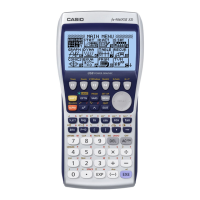E-11
• You can use the sum function to calculate the total of a range of cells. Select
the sum function from the {CEL} menu that appears when you input a leading
equals sign (=) into a cell.
Calculate the sales amount for Product A.
CDDDD
(=)?T(A)@?J(B)@U
• Enter the following calculation formula:
PRICE s QTY.
Next, calculate the sales amounts for Product B, C, and D.
D(EDIT)(COPY)
A(PASTE)A(PASTE)A(PASTE)
• You can use the {COPY} menu item to copy
the calculation formula you input for Product
A.
Finally, calculate the grand total for Products A through D.
)A(=)(CEL)(Sum))
?((C)@(:)?((C)CU
• Use the sum function to calculate the grand
total.
Graphing
Example: To graph a cubic function, and determine its roots, maximum value,
and minimum value
Graph the following function:
y = x
3
+2x
2
– x –2.
Use View Window to configure the graph screen coordinate values.
KD(GRAPH)
K(SET UP)(Line))
(V-WIN)
(INIT)
• Initialize the coordinate settings.
Input the function into area Y1.
)
T,BATVT
AU
Graph the function.
(DRAW)
Use the TRACE function to read the coordinates on the graph.
(TRCE)
Read the coordinate values as they are traced by the cursor.
CCCCC
Use the G-SOLVE function to calculate the roots of the graphed cubic function.
(G-SLV)(ROOT)
Calculate other roots.
C

